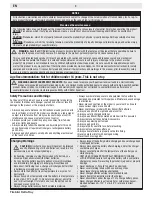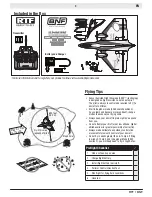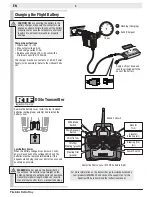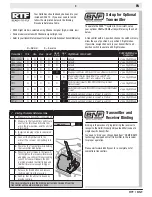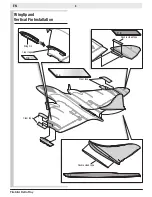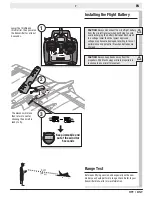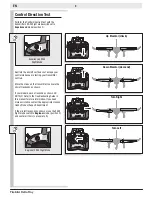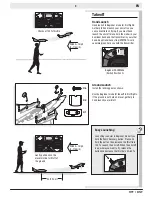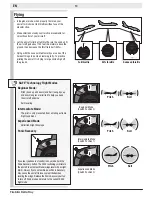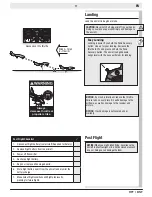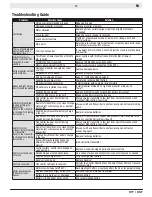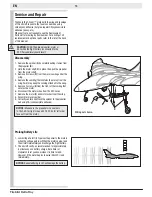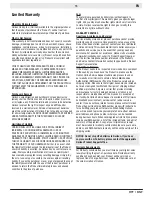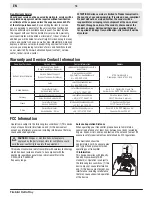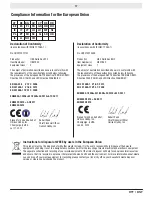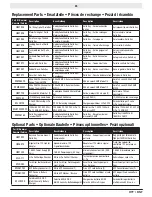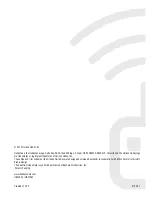
EN
13
RTF / BNF
Troubleshooting Guide
Problem
Possible Cause
Solution
Oscillation
Flying over recommended airspeed
Reduce air speed
Damaged propeller or spinner
Replace propeller or spinner
Motor vibration
Replace parts or correctly align all parts and tighten fasteners
as needed
Loose receiver
Align and secure receiver in fuselage
Loose aircraft controls
Tighten or otherwise secure parts (servo, arm, linkage, horn and
control surface)
Worn parts
Adjust gain to compensate for parts wear or replace worn parts (espe-
cially propeller, pivot points or servo)
Trim is at extreme and
aircraft does not fly
straight or level
Trim is not at neutral
If you adjust trim more than 8 clicks, adjust the clevis to mechanically
remove trim
Aircraft will not re-
spond to throttle but
responds to other
controls
Throttle not at lowest position or throttle
trim too high
Reset controls with throttle stick and throttle trim at lowest
setting
Throttle channel is reversed
Reverse throttle channel on transmitter
Motors disconnected from ESCs
Make sure motors are connected to the ESCs
Extra propeller noise or
extra vibration
Damaged propeller and spinner, collet
or motor
Replace damaged parts
Propeller is out of balance
Balance or replace propeller
Spinner is damaged or loose
Repair or replace damaged spinner
Reduced flight time or
aircraft underpowered
Flight battery charge is low
Completely recharge flight battery
Propeller installed backwards
Install propeller with numbers facing forward
Propellers are installed incorrectly
Install propeller marked R on right and propeller marked L on
the left
Flight battery damaged
Replace flight battery and follow flight battery instructions
Flight conditions may be too cold
Make sure battery is warm before use
Aircraft will not Bind
(during binding) to
transmitter.
Refer to the transmit-
ter manual for binding
instructions.
Transmitter too near aircraft during
binding process
Move powered transmitter a few feet from aircraft, disconnect and
reconnect flight battery to aircraft
Aircraft or transmitter is too close to large
metal object, wireless source or another
transmitter
Move aircraft and transmitter to another location and attempt binding
again
Flight battery/transmitter battery charge
is too low
Replace/recharge batteries
Bind switch or button not held long
enough during bind process
Power off transmitter and repeat bind process. Hold transmitter bind
button or switch until receiver is bound
Aircraft will not
connect (after binding)
to transmitter
Refer to the transmit-
ter manual for binding
instructions.
Transmitter too near aircraft during
connecting process
Move powered transmitter a few feet from aircraft, disconnect and
reconnect flight battery to aircraft
Aircraft or transmitter is too close to large
metal object, wireless source or another
transmitter
Move aircraft and transmitter to another location and attempt
connecting again
Flight battery/Transmitter battery charge
is too low
Replace/recharge batteries
Transmitter may have been bound to a
different aircraft using different DSM
protocol
Bind aircraft to transmitter
Control surface does
not move
Control surface, control horn, linkage or
servo damage
Replace or repair damaged parts and adjust controls
Wire damaged or connections loose
Do a check of wires and connections, connect or replace as needed
Flight battery charge is low
Fully recharge flight battery
Receiver is damaged
Replace Receiver
Controls reversed
Transmitter settings are reversed
Perform the Control Direction Test and adjust the controls on transmit-
ter appropriately
Motor power pulses
then motor loses
power
Normal Low Voltage Cutoff (LVC)
Recharge flight battery or replace battery that is no longer performing
Weather conditions might be too cold
Postpone flight until weather is warmer
Battery is old, worn out, or damaged
Replace battery
Battery C rating might be too small
Use recommended battery


